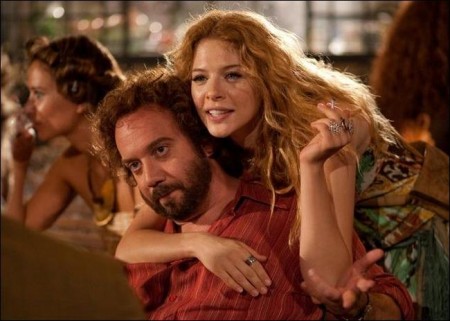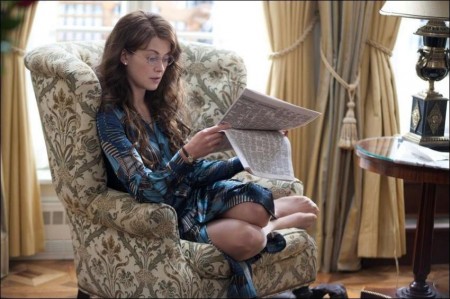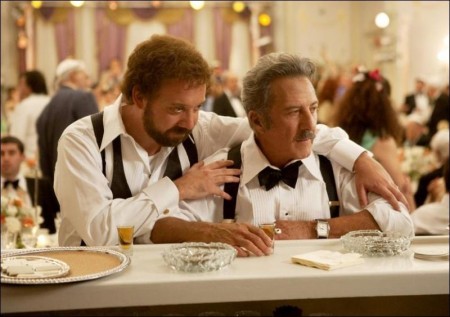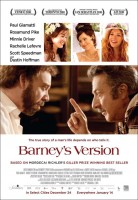Taglines: First he got married. Then he got married again. Then he met the love of his life.
Based on Mordecai Richler’s prize-winning comic novel–his last and, arguably, best–Barney’s Version is the warm, wise, and witty story of Barney Panofsky, a seemingly ordinary man who lives an extraordinary life. A candid confessional, told entirely from Barney’s point of view, the film spans three decades and two continents, taking us through the many highs, and a few too many lows, of our hero’s long and colorful life.
The reason that Barney must tell his story now–or, at least his version of it– is that his sworn enemy has just published a tell-all book that dredges up the more compromising chapters of Barney’s past: the many, often murky entrepreneurial schemes that lead to his success; the three marriages, all of them terminated; and, most problematically, the mysterious, as-yet-unsolved disappearance of Barney’s best friend, Boogie, a possible murder for which Barney remains the prime suspect. Since his memory sometimes fails him, and because he has the unfortunate habit of getting blind drunk at pivotal moments, Barney leads us on this somewhat unsteady walk down memory lane, not only to explain his life to others, but also to explain it to himself.
Mostly, we learn about Barney by witnessing his three marriages, each representing, like the rings of a circus, different “acts” of his life. There is his first wife, Clara, (Rachelle Lefevre), a flame-haired, flagrantly unfaithful free sprit with whom Barney briefly lives la vie de Boheme in Rome. Then, after returning home to CityplaceMontreal, Barney marries the “Second Mrs. P.,” (Minnie Driver), a wealthy Jewish Princess who shops and talks incessantly, barely noticing that Barney is not listening.
It is at their lavish wedding that Barney meets, and starts pursuing, Miriam (Rosamund Pike), the woman who will become his third wife, the mother of his two children, and the love of his life. Throughout their life together Barney is believed by many-including, at times, himself-to have murdered Boogie (Scott Speedman), the friend whom he both adores and envies, who simply vanishes one day, along with Barney’s youth.
In telling us, as he calls it, “the true story of my wasted life,” Barney is honest to a fault, owning up to every one of his flaws and failings with a self-lacerating wit that positively dares us not to like him. However, it’s impossible not to forgive someone as smart, funny, and self-aware as Barney. Not only does he turn out to be an unrepentant romantic man, as his lifelong devotion to Miriam attests, he is also capable of all kinds of sneaky acts of gallantry, generosity, and goodness when we -and he– least expect it. Far from “wasted,” his is a gloriously full life, played out on a grand scale. And, at the center of his story stands an unlikely, but unforgettable, hero–Barney Panofsky.
About the Production
Since his death in 2001 at the age of 70, Mordecai Richler‘s oeuvre – a body of work that encompasses ten novels, nine essay collections, three children‘s and two travel books, a short story collection, and more than a half-dozen screenplays, (including The Apprenticeship of Duddy Kravitz, which garnered him an Academy Award®-nomination) – remains one of the most significant literary legacies in Canada’s history.
BARNEY’S VERSION, the film adaptation of Richler’s last and arguably greatest novel, is not only a loving celebration of that legacy; it is also a rare example of a cinematic rendering of a major work of literature that does justice to its original source material. Starring Academy Award-Nominee Paul Giamatti as the eponymous Barney Panofsky, a seemingly ordinary man who ends up living a most extraordinary life, and Academy Award-Winner Dustin Hoffman as his father, Izzy, the film boasts an expansive ensemble cast that also includes Rosamund Pike, Academy Award-Nominee Minnie Driver, Rachelle Lefevre, Scott Speedman, Bruce Greenwood, Mark Addy, Jake Hoffman, and newcomer Anna Hopkins.
First published in 1997, Richler’s novel was instantly anointed as the author’s finest, with the Los Angeles Times proclaiming it Richler‘s great achievement and Time Magazine hailing it as exuberant, wonderfully written, and cunningly designed for maximum suspense and beaucoup laughs.” Barney Panofsky himself was named Richler‘s best hero yet. Nearly 400 pages in length, the book is a candid confessional as told by Barney when he, like Richler when he wrote it, was nearing 70 and feeling intimations of mortality.
Calling it ―the true story of my wasted life,‖ Barney‘s warts-and-all version of things reveals someone who is extremely self-aware when it comes to his own peculiarities, peccadilloes, and personal failings. But, those familiar with Richler‘s protagonists—both in the books and in the films adapted from them, such as The Apprenticeship of Duddy Kravitz, and Joshua Then and Now – know that even a deeply flawed character can be worthy of book-length/feature-length exploration.
Described as ―Falstaffian by The New York Times, Barney Panofsky has much in common with Shakespeare‘s bawdy, buffoonish anti-hero. Both are well known for their excessive consumption of alcohol, both are characters whom we alternately laugh with and laugh at, and both are primarily comic figures who reveal surprising depth when least expected. More importantly, both are easily forgiven — whatever their lapses and excesses may be — because they are completely open and frank about their shortcomings. These are men who fully acknowledge that they make trouble, and get into it, yet they accept complete responsibility for their actions.
It was his deep affection for Barney Panofsky that fueled Robert Lantos’ desire to bring Richler’s book to the screen. “I first read BARNEY’S VERSION when Mordecai sent me the manuscript,” recalls the producer, who had collaborated previously with the author, having produced the 1985 adaptation of Richler’s intensely autobiographical Joshua Then and Now, for which Richler himself did the screenplay. “The character of Barney speaks to me,” Lantos says, adding that, “this is a story of a life fully lived by a man with flaws and warts, but whose heart is in the right place.”
However, he notes, “not everyone knows this about Barney until the end,” referring to the character’s tendency to be his own worst enemy, and to hide his warmth and generosity beneath a gruff exterior. “I’m particularly attracted to someone who is underestimated by everyone, or misunderstood by everyone.” Of the book in general he says, “It stayed with me, it wouldn’t let me go. It was a novel written by one of my favorite authors, and it’s the best book he’s ever written.”
Stressing that the novel, like Barney (and Richler), hides its heart under a mask of irreverence and political incorrectness, Lantos observes that, “at a time when the western world, and especially where I live, has sheepishly flocked towards a dictatorship of the politically correct, making a movie based on this magnificently bawdy and wildly irreverent book, seems a necessity!”
A notorious satirist and political gadfly, Richler was a controversial social commentator who managed to ruffle more than a few feathers with his strong opinions about politics, religion, and society. About him, co-producer Lyse Lafontaine (who, like Richler and Lantos, hails from Montreal), says, “He managed, at one point in his life, to be totally hated by the three main communities here which, in those days, were the French Canadians, the WASPs, and the Jews. He had very clever opinions about society in general, and he was generous in his criticism of everybody; he was very democratic.”
Similarly caustic, curmudgeonly, and quick to offend friends and foes alike, (not to mention ex-wives and children), Barney Panofsky was undoubtedly created in Mordecai Richler’s image. Like Richler – and any number of his protagonists – Barney comes from Montreal’s Mile End area, a middle-and-working class neighborhood that was overwhelmingly Jewish in a city, province, and nation that is overwhelmingly not. Forever feeling like a second-class citizen, Barney tries desperately to “make it,” and embarks upon a series of business ventures – import/export, fund-raising and, ultimately, television production – that propel him to success. Regardless, Barney always feels unworthy, and longs to be the many things he is not. Though he has no obvious talent for anything other than making money, an olive oil-importing enterprise takes him to Rome, where he lives la vie de Boheme, and consorts with (and subsidizes) a host of artists, including his best friend Boogie (Scott Speedman), a Byronic writer, womanizer, and substance abuser, whom Barney both envies and adores, and Clara (Rachelle Lefevre), the flame-haired free-spirit who becomes the first Mrs. Panofsky.
Though she sleeps with all of his friends and subjects him to endless humiliation, Clara, who is both a painter and, better still, a shiksa, (or, so he believes), is Barney’s idea of “marrying up.” Though this union comes to a sudden and tragic end, Barney “marries up” again, when he returns to Montreal and weds the second “Mrs. P.” (Minnie Driver), a fabulously wealthy Jewish princess whose family connections help him get ahead. He will do it one more time by marrying Miriam, the third Mrs. Panofsky, whom he happens to meet at his wedding to the second. Miriam, who ends up being the love of his life, is beautiful, intelligent, patient – in short, perfect. Though the marriage lasts for decades and produces two children, sooner or later Barney is bound to screw it up, simply because he never feels that he deserves Miriam. And, screw it up he does.
Barney’s Version
Directed by: Richard J. Lewis
Starring: Paul Giamatti, Dustin Hoffman, Rosamund Pike, Macha Grenon, Paul Gross, Atom Egoyan, Rachelle Lefevre, Mark Camacho, Paula Jean Hixson
Screenplay by: Mordecai Richler, Michael Konyves
Production Design by: Claude Paré
Cinematography by: Guy Dufaux
Film Editing by: Susan Shipton
Music by: Pasquale Catalano
Costume Design by: Nicoletta Massone
Art Direction by: Michele Laliberte
MPAA Rating: R for language and some sexual content.
Studio: Sony ScreenGems
Release Date: January 14, 2011
Hits: 108







